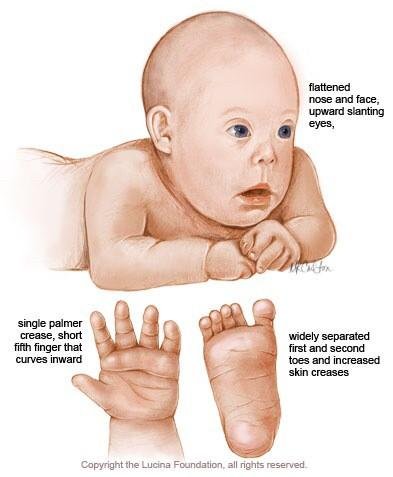Why we should test chromosome ?

A lot of patients ignore about this !
Until the children develop ..
Down syndrome ~ The trisomy of chromosomes 21
Abnormal development and systems Children will suffering with Down syndrome
Down syndrome is a chromosomal disorder caused by an error in cell division that results in an extra 21st chromosome.
The condition leads to impairments in both cognitive ability and physical growth that range from mild to moderate developmental disabilities.
Through a series of screenings and tests, Down syndrome can be detected before or after a baby is born.
Although the likelihood of having a child with Down syndrome is determined by many factors, medical research has shown a very high risk with advancing maternal age (mother's age >35 years old).
Down syndrome is caused by an extra copy of genetic material on all or part of the 21st chromosome.
Every cell in the body contains genes that are grouped along chromosomes in the cell's nucleus. There are normally 46 chromosomes in each cell, 23 inherited from the mother and 23 from the father.
When some or all of a person's cells have an extra full, or partial, copy of chromosome 21, the result is Down syndrome.
The most common form of Down syndrome is known as trisomy 21, a condition where individuals have 47 chromosomes in each cell instead of 46.
Trisomy 21 is caused by an error in cell division called nondisjunction, which leaves a sperm or egg cell with an extra copy of chromosome 21 before or at conception. This variant accounts for 95 percent of Down syndrome cases.
The remaining 5 percent of Down syndrome cases are due to conditions called mosaicism and translocation. Mosaic Down syndrome results when some cells in the body are normal while others have Trisomy 21.
Robertsonian translocation occurs when part of chromosome 21 breaks off during cell division and attaches to another chromosome (usually chromosome 14). The presence of this extra part of chromosome 21 causes some Down syndrome characteristics.
Although a person with a translocation may appear physically normal, he or she has a greater risk of producing a child with an extra 21st chromosome.
Characteristics of Down syndrome
Individuals with Down syndrome often have distinct physical characteristics, unique health issues, and variability in cognitive development.
Physical characteristics of Down syndrome include:
Eyes that have an upward slant, oblique fissures, epicanthic skin folds on the inner corner, and white spots on the iris
Low muscle tone
Small stature and short neck
Flat nasal bridge
Single, deep creases across the center of the palm
Protruding tongue
Large space between large and second toe
A single flexion furrow of the fifth finger
Individuals with Down syndrome usually have cognitive development profiles indicative of mild to moderate intellectual disability. However, cognitive development in children with Down syndrome is quite variable.
Children with Down syndrome often have a speech delay and require speech therapy to assist with expressive language. In addition, fine motor skills are delayed and tend to lag behind gross motor skills. Children with Down syndrome typically lag behind in their developmental milestones. The average age of sitting is 11 months, creeping is 17 months, and walking is 26 months.
Although many with the condition experience developmental delays, people with Down syndrome attend school and commonly become active, working members in the community.
Individuals with Down syndrome can have abnormalities affecting general health that may affect any organ system or bodily function. They have an increased risk of congenital heart defects, respiratory and hearing problems, Alzheimer's disease, childhood leukemia, epilepsy, and thyroid conditions.
However, people with Down syndrome also have a lower risk of hardening of the arteries, diabetic retinopathy, and most kinds of cancer.
Diagnosis of Down syndrome
Families at risk of having a child with Down syndrome often receive screening and diagnostic tests for the condition.
It is also standard for pregnant women older than 30 or 35 to receive genetic screens because the risk of having a child with Down syndrome is increased as women age.
Screening tests are used to estimate the risk that a fetus has Down syndrome, and diagnostic tests can definitively tell whether the fetus has the condition. Screening tests are a cost-effective and less invasive way to determine if more invasive diagnostic tests are needed.
However, unlike diagnostic tests, screening tests cannot give definite answers as to whether the baby has Down syndrome. Diagnostic tests, which are much more accurate in detecting Down syndrome and other problems, are usually performed inside the uterus and carry an extra risk of miscarriage, fetal injury, or preterm labor.
Screening tests include:
Nuchal translucency testing (at 11-14 weeks) - an ultrasound that measures clear space in folds of tissue behind the neck of a developing baby
Triple screen or quadruple screen (at 15-18 weeks) - measures the quantities of various substances in the mother's blood
Integrated screen - combines first trimester screening tests (with or without nuchal translucency) and blood tests with second trimester quadruple screen
Cell-free DNA - a blood test that analyzes fetal DNA found in the maternal blood
Genetic ultrasound (at 18-20 weeks) - detailed ultrasound combined with blood test results
Diagnostic tests include:
Chorionic villus sampling (at 8-12 weeks) - analysis of a tiny sample of placenta obtained from a needle inserted into the cervix or the abdomen
Amniocentesis (at 15-20 weeks) - analysis of a small amount of amniotic fluid obtained from a needle inserted into the abdomen
Percutaneous umbilical blood sampling (after 20 weeks) - analysis of a small sample of blood from the umbilical cord obtained from a needle inserted into the abdomen
Down syndrome can also be diagnosed after a baby is born by inspecting the infant's physical characteristics as well as blood and tissue.
Cr.http://www.medicalnewstoday.com/articles/145554.php
Hi! I am a robot. I just upvoted you! I found similar content that readers might be interested in:
http://www.medicalnewstoday.com/articles/145554.php
wow nice , thank you so much for up voted mind